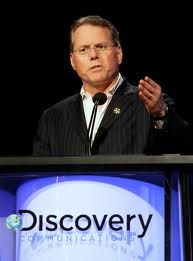Zaslav Says 'TV Everywhere' Revenues Are Hard to Pin Down

Having signed its first "TV Everywhere" deal, Discovery Communications CEO David Zaslav said the traditional cable market “feels quite healthy.” But at the same time, Zaslav said Discovery is looking at putting more-recent content on cable competitors like Netflix and Amazon.
Speaking at UBS's 41st Annual Global Media and Communications Conference in New York Monday, Zaslav said that behavioral changes by viewers haven’t yet started to affect the core business models of the TV business.
“This is a better time to be in the cable business than ever before, if you own your own content, Zaslav said.
Discovery recently signed its TV Everywhere deal. That allows Time Warner Cable to distribute Discovery content on online and mobile platforms. Zaslav declined to offer specifics about the TW Cable deal, but called TV Everywhere a good platform and that while it is taking longer than expected to roll out,. “It is measured, and if we can get fair value for it, we can get incremental revenue.” It is also good for consumers he said.
In terms of the TW Cable deal, the incremental revenue is difficult to break out,” Zaslav said. Discovery and TW Cable did a renewal of all of Discovery’s channels so “it’s hard to tell what we attribute to TV Everywhere” and what TW Cable attributes to TV Everywhere.
Zaslav said that it has tried to get what TV Everywhere is worth from distributors in stand-alone deals, but hasn’t broken through. Instead, he said it is easier to do TV Everywhere deals as part of larger renewals.
Discovery has also been doing deals with newer distribution platforms. While there’s been some impact on ratings because of content on streaming VOD providers such as Netflix and Amazon, Zaslav said, Discovery is looking at licensing some near content to those companies. He said that when programs with a story arc are available via streaming, it helps ratings of new live episodes. “These platforms are very good for us,” he said.
Multichannel Newsletter
The smarter way to stay on top of the multichannel video marketplace. Sign up below.
Discovery has also been active in its own online programming, with 70 YouTube channels, but he said the economics weren’t there yet. “Even though we’re a leader in the space, and we’re learning a lot, we’re not making much money”’ because there’s still not enough scale in streaming.
While advertisers were initially interested in streaming and possible moving ad dollars from traditional television, Zaslav said he sees those dollars coming back. “We don’t see any kind of a big move to digital.”
Zaslav also told the conference that because of soft ratings at Discovery and TLC, the company’s two biggest channels, domestic ad revenues will probably not reach the high single-digit growth rate the company forecast during its third-quarter earnings call.
On the other hand Oprah Winfrey’s OWN is doing very well. “You’ll see a significant amount of cash coming from OWN to us,” he said. “It’s a great story for Oprah and a great story for us at Discovery.”
Zaslav told the story of how Discovery content is used to fuel its networks around the world. Asked what might be the company’s next global network, he pointed to the success of male-oriented auto programming on Velocity and other channels around the world.
Jon has been business editor of Broadcasting+Cable since 2010. He focuses on revenue-generating activities, including advertising and distribution, as well as executive intrigue and merger and acquisition activity. Just about any story is fair game, if a dollar sign can make its way into the article. Before B+C, Jon covered the industry for TVWeek, Cable World, Electronic Media, Advertising Age and The New York Post. A native New Yorker, Jon is hiding in plain sight in the suburbs of Chicago.

